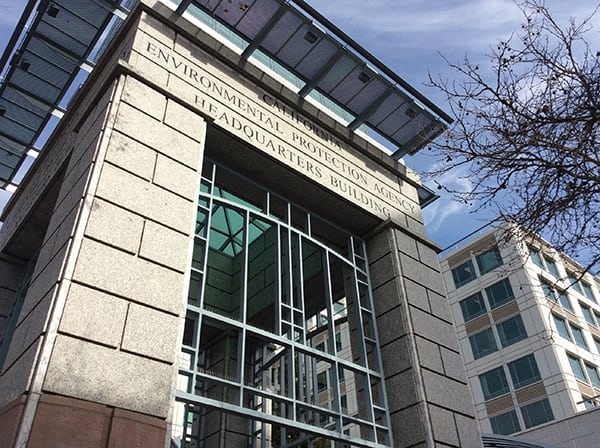
A sweeping new proposed rule published in the Federal Register by the Environmental Protection Agency (EPA) on April 6 establishes new nitrogen oxide (NOx) emissions budgets that will require fossil fuel–fired power plants in 25 states to participate in an allowance-based ozone season trading program starting in 2023.
The proposal, which builds on the agency’s existing Cross-State Air Pollution Rule (CSAPR), seeks to implement the EPA’s 2015 National Ambient Air Quality Standards (NAAQS) for ozone of 70 parts per billion by imposing federal implementation plans (FIPs) on these states using its authority under the “good neighbor” requirements of the Clean Air Act. States affected are: Alabama, Arkansas, Delaware, Illinois, Indiana, Kentucky, Louisiana, Maryland, Michigan, Minnesota, Mississippi, Missouri, Nevada, New Jersey, New York, Ohio, Oklahoma, Pennsylvania, Tennessee, Texas, Utah, Virginia, West Virginia, Wisconsin, and Wyoming.
The EPA’s existing CSAPR ozone-season NOx program limits NOx emissions from fossil fuel–fired electric generating units (EGUs) in 22 states during the ozone season, which runs from May 1 through September 30. If finalized, the rule would require power plants using coal, natural gas, and oil in the 25 affected states to participate in a revised version of the CSPAR NOx Ozone Season Group 3 Trading Program, which was previously established in the EPA’s March 2021–Revised CSPAR Update.
So far, only 12 states currently participate in the Group 3 trading program (Illinois, Indiana, Kentucky, Louisiana, Maryland, Michigan, New Jersey, New York, Ohio, Pennsylvania, Virginia, and West Virginia). The EPA will allow these states to remain in the group but it proposes to replace their existing emissions budgets with new emissions budgets. For eight states currently covered by the 2016-established CSAPR NOx Ozone Season Group 2 Trading Program that are already covered under state implementation plans or FIPs, the EPA proposes to issue new FIPs for two states (Alabama and Missouri) and amend existing FIPs for six states (Arkansas, Mississippi, Oklahoma, Tennessee, Texas, and Wisconsin) to transition power plants in those states from the Group 2 program to the revised Group 3 trading program, beginning with the 2023 ozone season. The EPA also proposes to issue new FIPs for five states not currently covered by any CSAPR NOx ozone season trading program: Delaware, Minnesota, Nevada, Utah, and Wyoming.
EPA’s First Proposed Emission Budgets for Industrial Stationary Sources
The broad 181-page proposed rule stems from a finding the EPA will make if the rule is finalized that interstate transport of ozone precursor emissions from 26 upwind states—which include the 25 states listed above plus California—is “significantly contributing to downwind nonattainment or interfering with maintenance of the 2015 ozone NAAQS in other states, based on projected NOx emissions in the 2023 ozone season.”
The proposal also notably establishes NOx emissions limitations beginning in 2026 for other industrial stationary sources (referred to as “non-EGUs” in the proposal)—marking the first time that the agency has proposed to impose emission budgets on sources other than EGUs pursuant to its authority under the good neighbor provision. These industrial sources include reciprocating internal combustion engines in pipeline transportation of natural gas; kilns in cement and cement product manufacturing; boilers and furnaces in iron and steel mills and ferroalloy manufacturing; furnaces in glass and glass product manufacturing; and high-emitting equipment and large boilers in basic chemical manufacturing, petroleum and coal products manufacturing, and pulp, paper, and paperboard mills. “Taken together, these strategies will fully eliminate the covered states’ significant contribution to downwind ozone air quality problems in other states,” the EPA said.
A ‘Groundbreaking’ Proposal
According to law firm Hunton Andrews and Kurth, while the EPA applies the same basic four-step process that it developed and used in previous CSAPR rulemakings, the proposed rule deviates from the EPA’s previous methodology in certain important ways. The law firm said the action amounts to “a proposal that is groundbreaking.”
“First, the proposed rule would limit NOx emissions from certain industrial stationary sources (referred to as ‘non-EGUs’ in the proposed rule), whereas previous CSAPR rules have only regulated emissions from EGUs,” the firm said. “Second, the proposed rule would include western states, including California, Nevada, Utah, and Wyoming, which were outside the modeling domain used in previous CSAPR rules.”
Finally, the proposed rule would include key features for the EGU portion of the program that were not included in the EPA’s previous transport rules, the firm noted. “These features include dynamic adjustments of emission budgets beginning with ozone-season 2025 and backstop daily emission rates for most EGUs. The proposed rule would impose ozone-season emission budgets on EGUs in covered states beginning in 2023, and on non-EGUs beginning in 2026.”
The timing is important because the proposal assumes that emissions reductions are achievable through immediately available measures. While the EPA said it evaluated a range of measures, including selective catalytic reduction (SCR) controls, selective non-catalytic reduction (SNCR) controls, and generation shifting, it determined that for the “regional, multi-state scale of this rulemaking, only fully operating and optimizing existing SCRs and existing SNCRs are possible for the 2023 ozone season.” However, it added, “Based on EPA’s assessment of the earliest possible timeframe for installation of new SNCR and SCRs, the EPA proposes to require emissions reductions commensurate with these controls by the beginning of the 2026 ozone season.”
—Sonal Patel is a POWER senior associate editor (@sonalcpatel, @POWERmagazine).
The post EPA Proposes Tighter Controls on NOx Emissions from Power Plants, Industrial Sources appeared first on POWER Magazine.